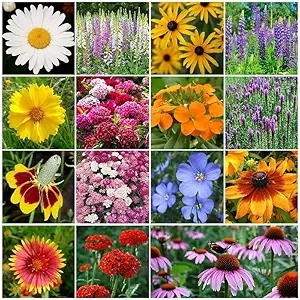- 100% Pure, Non-GMO Seeds – No fillers, favorites only! Includes 15 easy-to-grow species: Siberian Wallflower, Shasta Daisy, Lance Leaf Coreopsis, Sweet William, Foxglove, Purple Coneflower, Blanket Flower, Blue Flax, Perennial Lupine, Mexican Hat, Gloriosa Daisy, Black Eyed Susan, Candytuft, Gayfeather/Blazing Star, Maltese Cross
- Attracts Pollinators – With 5,000-10,000 square feet of ground cover, this non-GMO seed mix is sure to bring the bugs and birds to your yard! Easily attract bees, butterflies, and hummingbirds to pollinate blooms.
- Perfect for Zones 3-10 – This bulk outdoor mix is all perennial and suitable for all USDA hardiness zones, 3-10. These animal resistant, low-maintenance varieties prefer full sun and will produce mixed color blooms all summer through fall.
- Give the Gift of Beauty – Flower seeds are a gorgeous, eco-friendly gift that can provide lasting beauty outside your home for years to come! Perfect for birthdays, Mothers’ and Fathers’ Days, weddings, baby and bridal showers, and so much more, no matter where you live.
- High Germination – Eden Brother seeds are fresh, 100% pure, high germination, and non-GMO. Always. Our germination rates far exceed industry standards when planted according to instructions.
- Siberian Wallflower (Cheiranthus allionii), Shasta Daisy (Chrysanthemum maximum), Lance Leaf Coreopsis (Coreopsis lanceolata), Foxglove (Digitalis purpurea), Purple Coneflower (Echinacea purpurea), Blanket Flower (Gaillardia aristata), Blue Flax Perennial (Linum usitatissimum), Perennial Lupine (Lupinus perennis), Mexican Hat (Ratibida columnifera), Black Eyed Susan (Rudbeckia hirta), Gayfeather (Liatris spicata), Money Plant (Lunaria Annua), Daisy Gloriosa (Rudbeckia hirta), and more






From the brand
 Previous page
Previous page
Next page
Product Description

Plant the Wildflower Meadow of Your Dreams!
|
|
|
|
|
|---|---|---|---|
When to PlantSpring Planting: Best within a month or so after the final frost. The exact date varies based on region. Don’t plant to early, if seeds are sown prior to a late-season frost they will not germinate. Summer Planting: Adble only for cooler areas where temperatures don’t hover at 80° or more for long periods of time. Fall Planting: Most people plant in the spring, and that’s fine. But think about it. In the wild, when wildflowers “go to seed” after the flowers fade, that’s when the seed is ped. It simply falls to the ground and waits for the cycle through winter to spring. So the naturally-planted seed is planted in fall, not in spring. It’s best to wait until frost, then clear the ground of grasses and weeds, just like you would in spring. Use a shovel or rake for a small patch, or a rototiller for a bigger planting, and just spread the seed. It’ll be just fine through the winter, and be up and growing for you in very early spring. |
Where to PlantAverage Sunlight: Most wildflowers prefer full sun. Though many wildflowers do tolerate some filtered shade – and a few actually thrive in it – the vast majority are definiy sun-lovers and will likely demonstrate the strongest bloom where exposure is greatest. Soil Quality: Wildflowers will sprout in all but the most difficult conditions. Pampering your site with fertilizer or rich sod is not usually necessary. In fact, doing so can sometimes achieve the opposite result by inviting unwanted weeds and grasses. Only in the poorest of conditions, where the soil is literally sterile, is using an accelerant adble. Water Accessibility: A steady watering source is helpful, but not always necessary. In most regions natural rainfall will be sufficient to provide the water necessary. If you live in a arid region, are planting during drier months, or are experiencing prolonged drought, watering your site every other day for the first few weeks until root growth is established is advised. |
How to Prepare Soil & Decide Seed CoverageDetermine Coverage: We generally one standard seeding rate for all wildflower mixtures. See our ed coverage chart. Prepare the Soil: This is an absoluy vital step in the installation of any successful wildflower seed project. Though it may sound tempting to randomly cast your seeds into thin air and hope they will sprout, it is simply a waste of time and money to do so on a site that has not been properly prepared for planting. Though wildflower seeds are tenacious by nature – and a few might even persevere under the most inhospitable of circumstances – they, like all seeds, will perform best. Prepare your soil by hand or with a roto-tiller for larger jobs. |
How to Sow Your Seed1) The Hand-Broadcast Method (for smaller jobs): Simply scattering the seed evenly over the site by hand. 2) The Rotary or “Cyclone” Seeder (for larger jobs). This method accomplishes the same results through the use a hand-cranked spreader that can be purchased relatively cheaply at any garden center. |

Eden Brothers has taken the Safe Seed Pledge.
The Safe Seed Pledge






























